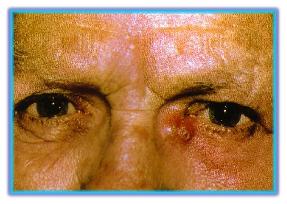| Acute dacryocystitis
prsents as a teder swelling over the lacrimal
sac,accompanied by pain,erythema,and discharge. Various
organisms can cause dacryocystitis; Streprococcus
pneumoieae and Staphylococcus aureus are the most
frequent offenders. Bacterial
infection can follow obstruction of the lacrimal system
at either end of the bony nasolacrimal canal.
Predisposing causes are nasal trauma,scarring from ocular
surface disease, or a developmental anomaly.
Systemic antibiotics are
indicated in the acute phase of the inflammation. Chronic
dacryocystitis producing permanent sacrring or fistula
formation requires dacryocystorhinostomy.
Perhaps as many as one
third of newborns can have a functional impatency of the
distal ends of the nasolacrimal duct,but this tends to
disappear spontaneously during the first few months of
life.
If this impatency does not
disappear,an acute or chronic dacryocystitis can ensue.
Massage of the lacrimal system,combined with systemic or
topical antibiotics,can be curative. If epiphora or
dacryocystitis persists,gentle probing and irrigation of
the lacrimal system may be necessary to restore patency.
|
 |

